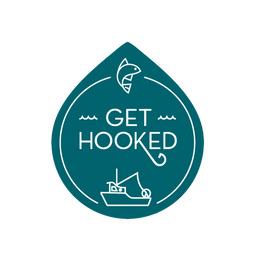Get Hooked Joins the Kelp Restoration Effort in Santa Barbara
Mar 12, 2025
Kelp forests are some of the most important ecosystems in the world’s oceans, providing shelter, food, and protection for countless marine species. In Santa Barbara, however, these critical kelp forests have faced severe declines mainly due to the explosion of purple urchins, which have overgrazed the remaining kelp after warmer waters from El Niño storms caused the kelp to die off in the 1980s.
This spring, Get Hooked Seafood is proud to be part of the Kelp Restoration Project in the Santa Barbara Channel, working alongside CFSB (Commercial Fishermen of Santa Barbara), The Nature Conservancy California (TNC), UC Santa Barbara (UCSB), and several local partners. Led by Kim Selkoe, co-founder of Get Hooked and Executive Director of CFSB, the project aims to restore the vibrant kelp forests by removing the purple urchins and exploring ways to turn this environmental challenge into a commercial opportunity.
The Kelp Crisis: An Urgent Call for Action
According to Kim Selkoe, the problem of purple urchins decimating the kelp forests has been decades in the making. “It’s really been the commercial sea urchin diving community that has noticed so much kelp decline out of the Channel Islands,” she shared. As the urchin population exploded, they’ve consumed the kelp, preventing it from regrowing and disrupting the entire marine ecosystem.
Historically, there was a rich, thriving kelp forest off the backside of San Miguel Island, but the combined impact of warmer ocean temperatures, coupled with overgrazing by urchins, led to the destruction of much of the kelp. As Kim explains, “We’ve gone from this rich, three-dimensional forest filled with fish, snails, invertebrates, and other algae, down to a carpeted urchin wasteland where nothing can grow.”
A New Collaborative Approach
The Kelp Restoration Project is about more than just removing urchins—it’s about bringing together scientists, fishermen, and restaurants to create a sustainable solution for the environment and the local economy. This unique collaboration is an exciting example of how community and science can work together to solve an environmental problem.
Kim Selkoe emphasizes the importance of this effort, saying, “It just makes sense to our community of divers that if we could just take the time and effort to clear out some of these areas, they might come back as kelp forests and be productive, both for biodiversity benefits as well as supporting the urchin fishery again.”
The project’s main goal is to remove purple urchins from affected areas, creating the necessary conditions for kelp to regenerate. In turn, this could help restore biodiversity in the region and ensure the continued health of local marine ecosystems.
Turning an Environmental Problem into a Commercial Opportunity
One of the most unique aspects of the project is the commercial opportunity it creates. Instead of simply removing the urchins with no value, the restoration effort includes sending the urchins to Cultured Abalone Farm, where they are "ranched" and fed a nutrient-rich diet to help restore their health and vitality. This makes them viable for culinary use and agricultural products, creating a sustainable food source and reducing waste.
At Get Hooked, we’re also taking a creative approach to turning the urchins into a valuable resource. We’re experimenting with drying and grinding the purple urchin shells into a calcium-rich powder to complement our fish hydrolysate fertilizer production. This allows us to close the loop in our supply chain, turning marine waste into a beneficial product that helps nourish the soil for local gardens and farms. It’s a win-win for the environment, local economies, and the sustainable seafood community.
A Long-Term Vision for Sustainability
While the immediate focus is on clearing out the purple urchins, the long-term goal is to see the kelp forests regenerate and thrive once again. Trent Petersen, another diver involved, emphasizes how this project bridges the gap between science and fishing: “It’s been really neat for me to learn the science behind things and try and look at it from a different perspective. I think the scientists we’re working with are also looking at it that way, where they’re happy to look at the fisherman’s side of it because essentially we’re the ones out there 100 days of the year.”
The partnership is a crucial first step, not only to address the kelp crisis but to create sustainable solutions for the future. Over the next two years, the project will continue to monitor and enhance the restoration efforts, ensuring that the kelp forests grow back strong and healthy.
Get Hooked's Role in the Restoration Effort
At Get Hooked, we’re grateful to play a part in the Kelp Restoration Project alongside CFSB, The Nature Conservancy, UC Santa Barbara, and local commercial fishermen. The project is a vital step in restoring the health of our oceans and protecting marine ecosystems. By working together, we’re hoping to help restore kelp forests and support sustainable practices that benefit the environment and local communities.
This initiative isn’t just about a singular company—it’s about a larger effort to foster collaboration between science, fishing, and conservation. The hope is that this project will lay the groundwork for lasting change in how we approach marine health and sustainability.
How You Can Help
The easiest way to take part in the effort is toooo... eat more local purple sea urchins! By supporting the harvesting and/or ranching of these urchins, you’re helping create a commercial solution that supports both marine restoration and local fisheries. This is an example of how we can all make a difference through culinary choices—by opting for sustainably sourced ingredients, we can contribute to environmental efforts while enjoying delicious, local seafood.



